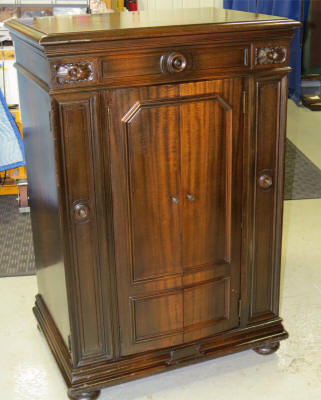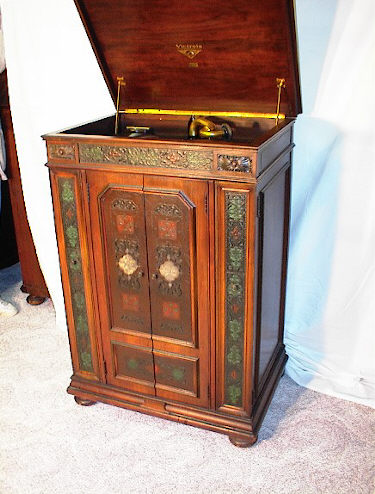
The Victor-Victrola Page
 Credenza
/ Credenza X / VV 8-1 / VV 8-30 / VE 8-30
Credenza
/ Credenza X / VV 8-1 / VV 8-30 / VE 8-30
RARITY: ¤ VALUE: ¤¤¤

The
Credenza (also referred to as the VV 8-1, and later as the
VV 8-30) was the first of four premiere Orthophonic models that were
introduced in the late fall of 1925, and represented the pinnacle of audio reproduction in the
mid-1920's. These revolutionary machines provided far better sound-quality than
any of the earlier Victrola models, with superior frequency response, higher
volume, and a far less "canned" sound quality than was experienced with the
previous generation of acoustic phonographs. For a description of the
Orthophonic design concepts, please refer to the page
Basics of the Acoustic
Phonograph.
Some Background: Since Christmas of 1923, Victrola sales
had been on a severe decline, but the
management team at Camden continued to manufacture and stockpile hundreds of
thousands of "old-style" Victrolas until the factory and
distributor storage spaces were bursting at the seams with unsold machines. Dealers faced the same
situation, as Victrolas simply were not selling due to the advent of low-cost
home radio sets. This crisis forced all operations to hold a half-price sale
during the summer of 1925 to clean-out the massive inventory of phonographs.
While the sale was a huge success for the buying public, the factory,
distributors and dealers were forced to sell the machines in their inventory at
a price below their original cost, resulting in large financial losses for all
stakeholders. Fortunately, most Victor
dealers were
also selling radios at that time, which helped to offset some of their losses,
but the factory had to write-off hundreds of thousands of dollars of depreciated inventory. Even worse, the
public perception of the Victrola brand, which had been so profitable and popular just
a few years earlier, was becoming tarnished. The massive financial problems that
the company was facing (including thousands of employee layoffs) was well-known to
everyone in the business and banking world. In order to survive, Victor
undertook a "panic" product-development effort, and thanks to some licensing
agreements with Western Electric, quickly designed and produced the Credenza
phonograph. The Credenza was the "flagship" of the new line of
Orthophonic models which the company was banking-on in order to survive. Due to
its large folded exponential horn and advanced soundbox technology, the Credenza
was capable of incredible sound quality. Once it was made available for public
viewing and listening, it became the center of attention at every
Victor dealership. In September 1925, a limited number of pre-production
Credenza machines (then labeled with an "8-1" designation) were toured around
the country and demonstrated to Victor's network of dealers to reinvigorate
interest and confidence in the Victrola product lines. Dealer feedback was very positive, and the
Camden plant shifted into full-gear to produce plenty of Credenzas in time for the official
Orthophonic launch-date of November 2. While not all four Orthophonic models in
the product lineup were ready in-time for the November premiere, the
flagship Credenza and entry-level Consolette were both in
plentiful supply for the buying public.
About
the Credenza: The Credenza was certainly an impressive
instrument. It featured the largest folded, exponential horn that Victor
produced at that time, along with their best (and recently improved) 4-spring motor.
Gold-plated hardware, a newly designed Orthophonic soundbox, an air-damped lid
closing system, and a fully-automatic turntable shut-off were a few of the main
features. A large and elegant cabinet gave this model a high-quality
appearance. Gold-plated hardware was used.
The "prototype" Credenzas which were produced for the September dealer tour were
tagged as VV 8-1 and used a semi-opaque blended red-brown varnish finish
(top right).
Cabinet relief carvings and some other very minor details were slightly different from the later
production versions. Based on surviving examples, it is estimated
that about 50 of these demonstration machines were built.
The product that was officially launched for public sale in November was
produced with a lightly-stained and blended satin lacquer finish (top left). Buyers had an
option of mahogany or walnut veneers. The 8-1 model name on the dataplate was
replaced with Credenza. This substantial phonograph retailed for $275.00,
which equates to about $4,100.00 in today's money. The impact on buyers in the
dealer showrooms was sensational, to say the least. Even at this high
price-point, machines were being sold faster than the plant could produce them.
The Credenza, along with some other advanced models introduced that fall,
literally saved Victor from financial collapse; the company knew it had a huge success on its hands.
huge success on its hands.
Listen
to a comparison of the Credenza vs. a small Orthophonic model such as the
Consolette or Colony. Click on the links below. No wonder it was such a success!
Microphones were
placed 6 feet in front of the horns, playing the same record and using the same
soundbox in the same room. No gain or equalization adjustments have been made.
CREDENZA
CONSOLETTE
The larger folded horn of the Credenza provides vastly superior bass response,
as well as a greater overall volume. This would have been what buyers
would have experienced in the Victor showrooms in 1925, when comparing different
Orthophonic models.
One of the early complaints about the Credenza was the awkwardness of the very large doors. They
had to be fully open to listen to records (or to retrieve them from the storage
areas along the sides) and this required a great deal of "swing-space" around
both the front and sides of the machine (above left). This problem was solved in
early 1926 by producing a design that had separate doors for the record storage
areas and the horn opening (right). At the same time, the retail price was
increased to $300.00. In mid-1926, the turntable location was moved from the
center of the motorboard to the far right, and shortly thereafter a padded
"record rest" appeared on the left. This was used to hold the next record to be
played. Moving the turntable and motor to the right had the benefit of shortening the length of the crank
handle, making it far easier to install into the motor's female threaded
opening. Changes were also made to the cabinet's relief carvings and trim. At
some point during this period, Victor made a money-saving move, and started
using pot metal in their Orthophonic soundboxes, replacing the all-brass
housings used previously. Unfortunately, pot metal tends to swell and distort
over time, and may of these soundboxes have developed cracks and can become
unusable today.
Victor began using only numeric designations for their machines (rather than
names) in the spring and summer of 1926, and the updated Credenza became the VV
8-30. The design remained essentially the same through the end of 1927,
when the 8-30 was quietly discontinued. During the final months of the production run,
approximately 5,000 Victrola 8-30 "E" machines were also produced for export
outside the USA. These machines are identical to the US versions, but have a
different licensing tag. No records exist to accurately date "E" machines, but
most were manufactured in the late 1927-early 1928 timeframe. A total of 63,000
spring-wound Credenza and VV 8-30 models were produced, not including machines
built for export or other special purposes.
 For
an extra $50.00, the buyer could opt for a "hand-tooled leather" decoration on the
front of the cabinet (left). Based on the number of surviving examples, this was
not a popular choice when new, but these examples are very popular with
collectors today.
For
an extra $50.00, the buyer could opt for a "hand-tooled leather" decoration on the
front of the cabinet (left). Based on the number of surviving examples, this was
not a popular choice when new, but these examples are very popular with
collectors today.
Some very late Credenzas have reportedly been documented with an "RCA-Victor"
license sticker, indicating that some remained in factory inventory until after
RCA purchased Victor in 1929. Invoices show that dealers were still selling
these models well into in the early 1930's, but this was certainly left-over old
stock. Some late-production examples used a combination of walnut and mahogany
veneer, with the walnut typically used under the lid. This was probably done to
use-up the stock of veneer in the factory, as the grain patterns do not match
well. This was a common practice at Victor; when certain models were becoming
obsolete, all the inventory of remaining cabinets and parts were essentially
fitted together ad-hoc to get them shipped out the door.
The Credenza was also available with an electric motor option (Credenza X
or VE
8-30 X) for $35.00 extra, and a total of 28,300 of these machines were
produced (note that a large series of serial numbers were skipped in
production). In addition a Credenza U model was produced in very low volumes; this version
would run on either AC or DC current.
A limited number of VV 8-30-S models
were also produced. These phonographs are basically the same as a standard
8-30, but with provisions to mount a radio in the cabinet. Based on surviving
examples, approximately 500
of these machines were shipped from the factory. However, this model does
not appear in any contemporary catalogs nor in the factory production records.
Some Credenzas sold in Canada have a "C" prefix; however it is not certain if
these machines were assembled in Montreal, or if they were built at Victor's
main plant in Camden NJ
for export into Canada.
Credenza / 8-30 models are often prized by both collectors and audiophiles
today, even in the very weak current market. When the soundboxes are correctly
rebuilt, and the horn has been checked for leaks (and sealed if necessary),
these machines can produce a splendid sound that rivals, and often exceeds, the
audio quality of premium AM radios today.
The current survival database shows the earliest existent 8-1 /Credenza / 8-30 to be S/N 531 and the latest to be S/N 63201
The earliest existent electric Credenza X (8-30 X) is S/N 585 and the latest is 31797
| Manufacture Date | Serial Number Range | Feature Notes |
| 1925 | 501-10500 | Earliest models all use 2 door design |
| 1926 | 10551-55000 | All models use 4-door design after S/N 15000. Record support added at S/N 33800. 8-30 name change implemented around S/N 45000 |
| 1927 | 55001-63500 | |
| Credenza X or 8-30 X (Electric) | ||
| 1925 | 501-2500 | Most
early models use 2 door design |
| 1926 | 2501-22800 | Serial numbers 12,520 through 16,000 were skipped (not used) in production. 8-30 name implemented at S/N 16000 |
| 1927 | 22801-31800 |
Do you own a Victor Credenza / 8-30 ? Please take a moment and enter some basic information about your machine into the collector's database by clicking here. No personal information is required.